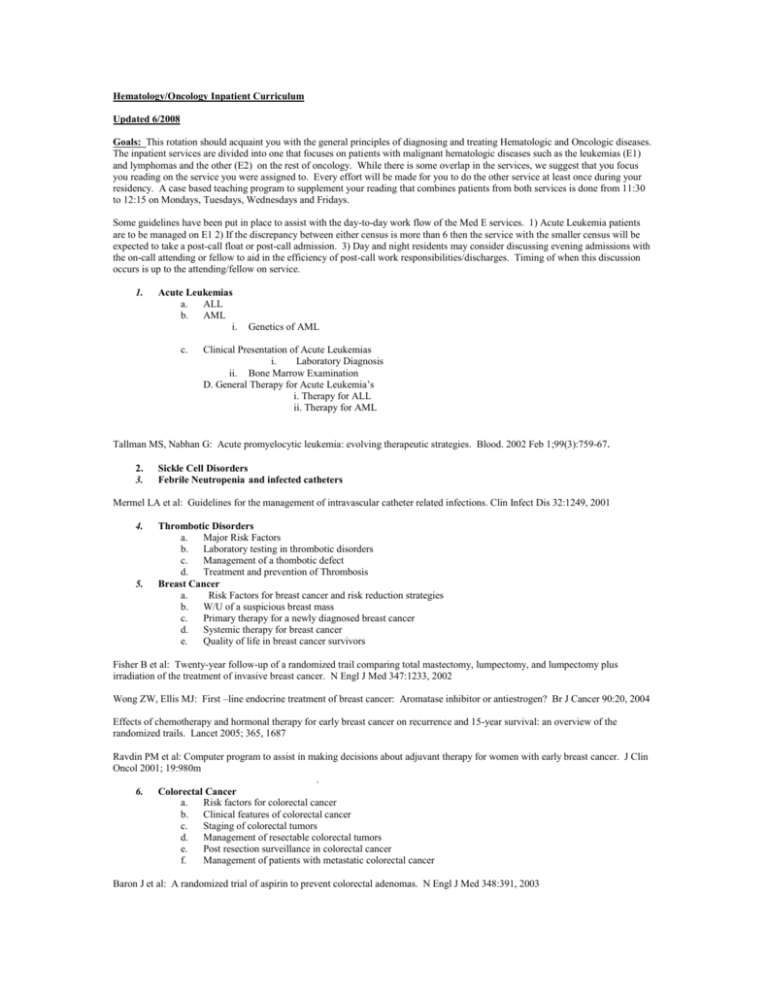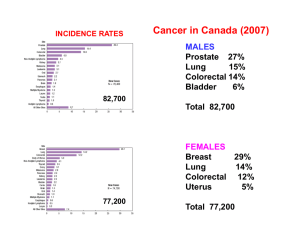Hematology Oncolology Inpatient Curriculum 2008
advertisement

Hematology/Oncology Inpatient Curriculum Updated 6/2008 Goals: This rotation should acquaint you with the general principles of diagnosing and treating Hematologic and Oncologic diseases. The inpatient services are divided into one that focuses on patients with malignant hematologic diseases such as the leukemias (E1) and lymphomas and the other (E2) on the rest of oncology. While there is some overlap in the services, we suggest that you focus you reading on the service you were assigned to. Every effort will be made for you to do the other service at least once during your residency. A case based teaching program to supplement your reading that combines patients from both services is done from 11:30 to 12:15 on Mondays, Tuesdays, Wednesdays and Fridays. Some guidelines have been put in place to assist with the day-to-day work flow of the Med E services. 1) Acute Leukemia patients are to be managed on E1 2) If the discrepancy between either census is more than 6 then the service with the smaller census will be expected to take a post-call float or post-call admission. 3) Day and night residents may consider discussing evening admissions with the on-call attending or fellow to aid in the efficiency of post-call work responsibilities/discharges. Timing of when this discussion occurs is up to the attending/fellow on service. 1. Acute Leukemias a. ALL b. AML i. c. Genetics of AML Clinical Presentation of Acute Leukemias i. Laboratory Diagnosis ii. Bone Marrow Examination D. General Therapy for Acute Leukemia’s i. Therapy for ALL ii. Therapy for AML Tallman MS, Nabhan G: Acute promyelocytic leukemia: evolving therapeutic strategies. Blood. 2002 Feb 1;99(3):759-67. 2. 3. Sickle Cell Disorders Febrile Neutropenia and infected catheters Mermel LA et al: Guidelines for the management of intravascular catheter related infections. Clin Infect Dis 32:1249, 2001 4. 5. Thrombotic Disorders a. Major Risk Factors b. Laboratory testing in thrombotic disorders c. Management of a thombotic defect d. Treatment and prevention of Thrombosis Breast Cancer a. Risk Factors for breast cancer and risk reduction strategies b. W/U of a suspicious breast mass c. Primary therapy for a newly diagnosed breast cancer d. Systemic therapy for breast cancer e. Quality of life in breast cancer survivors Fisher B et al: Twenty-year follow-up of a randomized trail comparing total mastectomy, lumpectomy, and lumpectomy plus irradiation of the treatment of invasive breast cancer. N Engl J Med 347:1233, 2002 Wong ZW, Ellis MJ: First –line endocrine treatment of breast cancer: Aromatase inhibitor or antiestrogen? Br J Cancer 90:20, 2004 Effects of chemotherapy and hormonal therapy for early breast cancer on recurrence and 15-year survival: an overview of the randomized trails. Lancet 2005; 365, 1687 Ravdin PM et al: Computer program to assist in making decisions about adjuvant therapy for women with early breast cancer. J Clin Oncol 2001; 19:980m . 6. Colorectal Cancer a. Risk factors for colorectal cancer b. Clinical features of colorectal cancer c. Staging of colorectal tumors d. Management of resectable colorectal tumors e. Post resection surveillance in colorectal cancer f. Management of patients with metastatic colorectal cancer Baron J et al: A randomized trial of aspirin to prevent colorectal adenomas. N Engl J Med 348:391, 2003 Walsh JME, Terdiman JP: Colorectal cancer screening; JAMA 289:1288, 2003 7. Lung Cancer a. Clinical presentation of lung cancer b. Diagnosis and treatment of lung cancer c. Non-Small Cell Lung cancer d. Small Cell Lung cancer American College of Chest Physicians: Diagnosis and management of lung cancer: ACCP evidence based guidelines. Chest, 123:1S, 2003 8. Cancer of Unknown Primary Site a. Adenocarcinoma of Unknown primary site b. Squamous cell carcinoma of unknown primary site c. Poorly differentiated carcinoma of unknown primary site Hainsworth JD, Greco FA: Management of patients with cancer of an unknown primary site. Oncology 14:563, 2000 9. Lymphadenopathy, lymphoma and Multiple Myeloma Diehl V et al: Part II: Hodgkin’s lymphoma---Diagnosis and treatment. Lancet Oncol 5:19, 2004 Barlogie B et al: Treatment of multiple myeloma. Blood 103:20, 2004 10. Prostate Cancer a. The screening controversy b. Treatment of prostate cancer c. The Gleason Score d. Comparison of Treatment modalities e. Sequelae of treatment in prostate cancer f. Management of recurrent prostate cancer Nelson WG et al: Prostate cancer. N Engl J Med 349:366, 2003 11. Testicular Cancer Bosl GJ et al: Testicular germ-cell cancer. N Engl J Med 337:242, 1997 12. Oncologic Emergencies a. Metabolic Emergences (Hypercalcemia, Hyperuricemia, and Hyponatremia) b. Hematologic Emergency: DVT c. Mechanical Emergencies (Spinal Cord Compression, SVC, Pericardial Effusión and Tamponade) Strewler GJ: The parathryid hormone-related protein. Endocrinol Metab Clini North Am. 29:629,2000 Yim BT et al: Rasburicase for the treament and prevention of hyperuricemia. Ann Pharmacotherapy 37:1047, 2003 13. Chemotherapy, biotherapy and hematopoietic colony stimulate factors: 2000 update American Society of Clinical Oncology : Update of recommendations for use of hematopoietic colony stimlating factors: Evidence-based clinical practice guidelines. J Clin Oncol. 2000 Oct 15;18(20):3558-85 14. Antiemetics Wiser, W. Practical management of chemotherapy-induced nausea and vomiting. Oncology (Williston Park). 2005 Apr;19(5):637-45. Review. 15. Pain Management Levy MH: Pharmacologic treatment of cancer pain. N Engl J Med 335:1124, 1996





